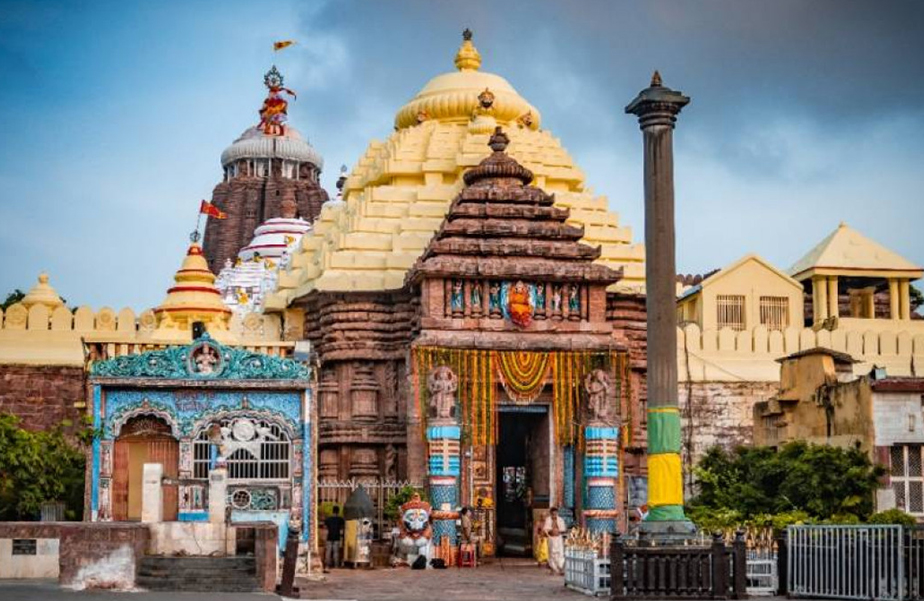Context:
The Odisha government is poised to launch an Rs 800-crore temple project centred around the Jagannath Temple in Puri.
Shree Parikrama Project:
- This initiative aims to enhance the infrastructure for devotees visiting the temple, aligning with the broader vision of transforming Puri into an international heritage hub.
- This initiative was taken aftermath of Cyclone Fani’s devastation in May 2019.
- The Parikrama project is focused on constructing a 75-meter corridor encircling the Jagannath temple complex, providing pilgrims with a visual connection to the sacred site.
Key Features of the Project:
As per the Shree Jagannath Temple Administration (SJTA), the project includes:
- A seven-meter buffer zone featuring a terraced green landscape.
- A ten-meter path designed for ceremonial processions and public use.
- A fourteen-meter landscape zone adorned with local trees and shrubs.
- An eight-meter shaded pathway catering to visitors.
- A ten-meter zone housing facilities such as restrooms and information kiosks.
- A four-and-a-half-meter service lane.
- A dedicated emergency lane spanning seven and a half meters.
- A traffic lane of seven meters.
- A footpath of seven meters, equipped with parking and essential amenities.
Jagannath Puri Temple:
- Jagannath Puri Temple located in Puri, Orissa, India is one of the Char Dham pilgrimage sites.
- It was built by Anantavarman Chodaganga, King of the Ganges Dynasty, in the 12th century AD.
- It is sacred to all Hindus, especially Vaishnavas. According to mythology, Lord Jagannath is believed to be an incarnation of Lord Vishnu.
- The temple is associated with the legendary story of Lord Krishna, his brother Balabhadra, and his sister Subhadra.
- It attracts followers of Gaudiya Vaishnavism, including Chaitanya Mahaprabhu who lived in Puri.
- Vaishnava saints like Ramanujacharya, and Madhvacharya, are associated with this temple.
- Emar Mutt by Ramanuja and Govardhana Mutt by Adi Shankaracharya closely linked to the temple.
Architecture:
- Jagannath Temple represents a pinnacle of Kalingan Architecture, known for its intricate designs and cultural significance.
Temple Layout:
- Positioned at the centre of an inner courtyard on a raised platform.
- Comprises four essential components: Vimana, Jagamohana, Natamandapa, and Bhogamandapa.
Architectural Composition:
Vimana or Deula (Garbagriha):
- A viman is the structure that covers the inner sanctum or garbhagriha, where the main deity is installed.
- Rekha deula is built in Nagara style and characterized by curvilinear towers (sikhar).
- Neelchakra is the metal wheel mounted on the top of the Jagannath Temple in Puri. It is made of eight metals and represents the Sudarshana Chakra, the powerful weapon of Lord Vishnu.

Jagamohana:
- A Jagamohana is an assembly hall.
- It is located in front of the main shrine of the temple, called the garbhagriha.
- It is usually shaped like a pyramid, with several stories or levels called tala.
- The Jagamohana represents the cosmic space and connects the deity with the divine.
Natamandapa:
- Also known as the audience hall.
- Aligned in an east-west direction with axial precision.
Bhogamandapa:
- Serves as the hall for residuary offerings.
- Positioned in a row with Natamandapa for a cohesive architectural layout.
Architectural Style:
Combination of Rekha and Pidha Styles:
- The architectural style is a combination of Rekha and Pidha.
- Vimana follows the Rekha deula, and Jagamohana is in the Pidha deula style.
Pancha Ratha Ground Plan:
- Vimana is built on the Pancha Ratha ground plan.
- Vertical structure is divided into five projected columns or pillar-like structures on each side.
Vertical Division:
Both Vimana and Jagamohana are divided into five principal parts along the vertical plane through the foundation.
- Pishta or Pitha
- Bada (vertical wall)
- Gandi (curvilinear tower)
- Pyramidal roof (in the case of Pidha deula)
- Mastaka (crowning elements)
Gates and Carvings:
Four Gates: Each gate is adorned with carvings corresponding to different forms.
- Eastern ‘Singhdwara’ (main gate) with crouching lions.
- Southern ‘Ashwadwara.’
- Western ‘Vyaghra Dwara.’
- Northern ‘Hastidwara.’
Significance:
1. Pilgrimage Destination:
- Jagannath Puri Temple is one of the four major pilgrimage sites (Char Dham) for Hindus.
- Pilgrims visit the temple to seek the blessings of Lord Jagannath.
2. Rath Yatra:
- The annual Rath Yatra, or chariot festival, is a major event where the deities are placed on grand chariots and pulled through the streets by devotees.
- Millions of devotees participate in this vibrant festival.
3. Religious and Cultural Hub:
- The temple serves as a centre for religious and cultural activities, hosting various festivals and rituals throughout the year.
4. Nabakalebara:
- The Nabakalebara ceremony, involving the replacement of the deities’ wooden idols, occurs at intervals and attracts devotees from far and wide.
Conclusion: Jagannath Puri Temple stands as a symbol of rich cultural and religious heritage. Its ancient origins, unique architecture, and annual festivities make it a revered pilgrimage site, attracting devotees and tourists alike.

